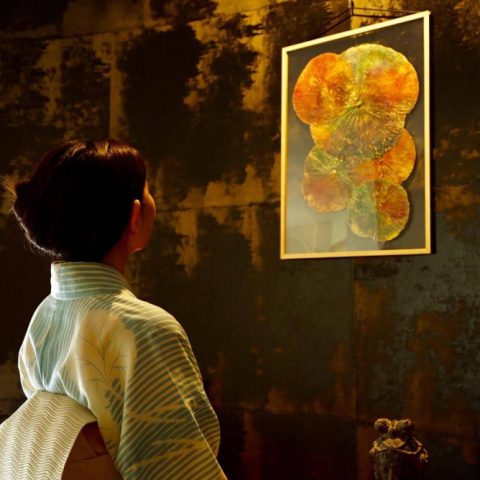
In Japan, the beauty of each season is celebrated through special words known as ‘kigo (季語)’ in haiku and poetry. These words capture the essence of nature and life during spring, summer, autumn, and winter. Understanding and using these terms adds a romantic touch to the Japanese language.
One of my favorite seasonal words is “ajisai (紫陽花),” or hydrangea. Hydrangeas bloom during the rainy season, serving as a reminder of the transition from the rainy season to early summer. We always experience these seasonal changes through Kigo including flowers and clothing, feeling them in our daily lives. Do you have a favorite seasonal flower?
Today we’ll explore the enchanting world of Plum blossoms with their unique significance in Japanese culture.
The Deep Connection Between Japanese People and Plum Blossoms
In Japan, plum blossoms symbolize good fortune, an auspicious flower, along with pine and bamboo, and the arrival of early spring. They are often used as the design for New Year’s greeting cards and other celebratory occasions.
Other famous flowers that represent the seasons are sakura (cherry blossoms), and momo (peach blossoms). Cherry blossoms are beloved as a symbol of hanami (flower viewing) and events like entrance and graduation ceremonies. Peach blossoms are associated with Hina Matsuri, the Peach Festival, or Doll’s Festival.

Japanese wine made from plum fruits. Photo Credit: Luna Wang
Those who are interested in Japan or have lived in the country might have heard of sour umeboshi (梅干し) or plum wine (梅酒). These products are all made from the fruit of the plum tree.
The importation of plums from China to Japan took place about 1500 years ago, but only the medicinal use of plums was imported at first. Then, the plum trees themselves came to Japan. Interestingly, Japanese people enjoyed the flowers more than the fruit itself.
In fact, a collection of Japanese poems called ‘the Manyoshu’ from the Nara period contains numerous poems featuring plum blossoms as their subject.
When they start to bloom, many gardens in Japan hold a variety of events! Since it is still cold in late January, temporary tea ceremonies are set up where visitors can enjoy matcha tea and amazake (sweet fermented rice drink) while admiring the view. It’s a delightful and traditional way to celebrate the beauty of the season.
How To Distinguish Plum Blossoms?
All three of these types of blossoms appearance is similar and they all belong to the Rosaceae species. It can be challenging to distinguish them from a distance, but by focusing on their petal shapes, blooming period, and fragrance, you can easily tell them apart.
First, please pay attention to the petals.

Photo Credits: Jelleke Vanooteghem, Yosuke Ota, and 八宝菜うどん. Photoshopped: Chisato (Canva)
If there are notches in the petals, they’re cherry blossoms. Plum blossoms have round petals, and pointed petals indicate peach blossoms.
Next, let’s focus on the timing of leaf and flower opening. If only the flowers are open, they’re plums. If both the leaves and flowers are open simultaneously, they’re peaches. Additionally, cherry blossoms typically have multiple flowers on one stem.
Secondly, the order of blooming is usually plum, followed by peach, and lastly, cherry. While there may be variations due to regional and climatic differences, knowing their respective blooming timings allows you to distinguish which flower is in bloom.
Plum Blossoms:
Bloom from late January to late April, starting as early as mid-December for some varieties.
Peach Blossoms:
Bloom from mid-March to late April, often overlapping with sakura and following a similar blooming pattern.
Cherry Blossoms:
Bloom from mid-March to early May, with the earliest showing up in warm regions like Okinawa and the latest in colder areas like Hokkaido.

The shape of the plum blossom. Photo Credit: yamasa-n
Lastly are fragrance and colors. Plum blossoms can be categorized into white and red varieties with complex color shifts. One of their significant characteristics is that different-colored flowers can bloom on the same tree. This is because plum trees are prone to minor genetic mutations, causing variations in the flower colors. They have a soft, jasmine-ish smell.
The color of momo varies among the different species, encompassing shades of white, pale pink, deep pink, and even red. The fragrance is subtle, with a little sweetness from both the flowers and leaves.
Depending on the species, sakura comes in various colors, including white, light pink, and dark pink. Some have a stronger and sweet aroma with hints of almonds, vanilla, and rose. However, our most common species “Somei Yoshino” has a very faint scent.
Where to Enjoy Japanese Plum Blossoms?
- 御座敷梅林青輝園 ~Ozaseki Bairin Seikien~ In Fukuoka

Plum bonsai. Photo Credit: 素君
In an 80-year-old traditional wooden building, you can enjoy the beauty of 100 to 200-year-old historical plum bonsai trees. As you walk into the room, the enchanting fragrance of plum blossoms fills the air and allows you to immerse yourself in Japan’s beauty! Make sure to check the website for information on the event dates, pricing, and more!!!
Address: https://maps.app.goo.gl/wuLRLJXtvxH83PSN8
Website: https://seikien.com/ - 大阪城公園 ~Osaka Castle Park~

Osaka Castle and Plum trees. Photo Credit: hiyori
Enjoy the plum blossoms with Osaka Castle in the background. It’s a perfect spot for photos!! There are around 100 species and 1,270 plum trees in bloom. From early-blooming to late-blooming, you can see plum blossoms for an extended period.
Don’t forget to follow our Instagram and tag us @arigatojapan with your photos.
Address: https://maps.app.goo.gl/XJLF1dDMA3kXyHD87
Website: https://www.osakacastlepark.jp/?lang=en - 鈴鹿の森庭園 ~Suzuka Forest Garden~ in Mie

White plum blossom. Photo Credit: jamie_nakamura
In Suzuka Forest Garden, located in Suzuka City, Mie Prefecture, you can enjoy approximately 200 weeping plum trees. In particular, the renowned double-blooming “Kurehashidare” stands out indeed. Why not savor the beauty of the weeping plum trees that are over 100 years old?
Address: https://maps.app.goo.gl/Dwd3NiJft6FujvuV6
Website: https://www.akatsuka.gr.jp/group/suzuka/ - 偕楽園 ~Kairakuen~

Kairakuen and Plum Festival. Photo Credit: あじあっし
Located in Mito City, Ibaraki Prefecture, Kairakuen is one of Japan’s three famous gardens. This garden allows you to experience the ambiance of the Edo period, evoking a sense of old-world charm and elegance. Kairakuen has approximately 100 varieties and 3,000 plum trees. “Mito Plum Festival” takes place from mid-February to late March, allowing visitors to enjoy this splendid sight every year.
Address: https://maps.app.goo.gl/4Hab9f8CfAxVogcq8
Website: https://ibaraki-kairakuen.jp/en/language/ - 湯島天満宮 ~Yushima Tenjin Shrine ~

Yakanbai. Photo Credit: 安西成文
Here, around 20 varieties and around 300 plum trees will be in full bloom. The best part is admission to the plum festival is free. Furthermore, they illuminate the plum trees during the “Yakanbai” event in the evenings. If you’d like to enjoy the plum blossoms in a lively atmosphere, be sure to visit here!
Address: https://maps.app.goo.gl/QV39SE755N8z7KBU9
Website: https://www.yushimatenjin.or.jp/pc/index.htm
In Japan, plum blossoms are more than just beautiful flowers. They are a cultural symbol with deep historical significance. The next time you see them, remember what they bring and what they mean, and I hope you enjoyed reading about them today!
Featured image by Rena
Book a personal travel consulting call with our experts to get great tips for your trip and suggestions about off-the-beaten-track destinations in Japan!




